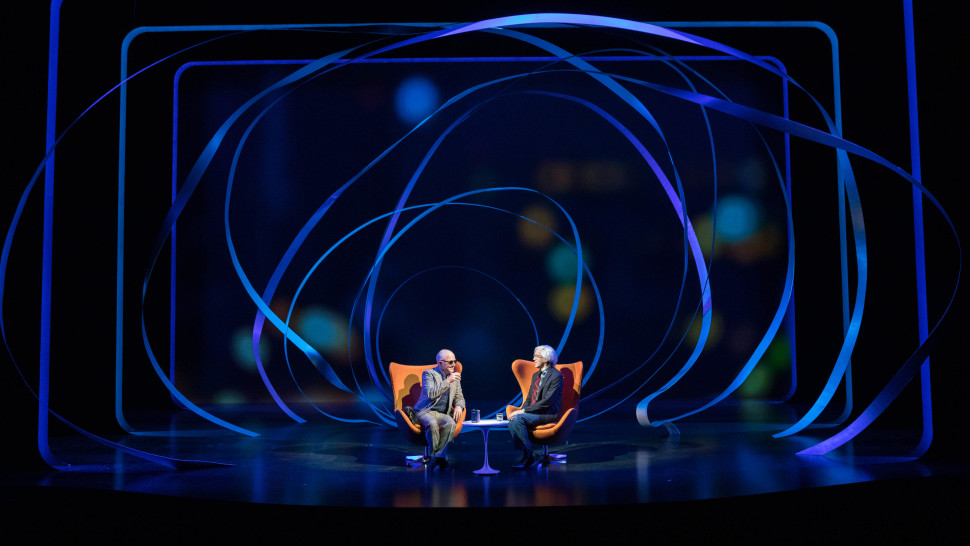A Look at the A.R.T.’s ‘WarholCapote: A Nonfiction Invention’

Photo Credit: Gretjen Helene Photography, playbill.com
Ian Sloan ‘21/Emertainment Monthly Stage Section Assistant Editor
During the height of their careers, author Truman Capote (In Cold Blood, Breakfast at Tiffany’s) and artist Andy Warhol (Campbell’s Soup Cans, Marilyn Diptych) decided that they should write a play together. Although that play never materialized, Warhol recorded many of his conversations with Capote hoping to gain material for the stage. These conversations set up the main premise for WarholCapote: A Nonfiction Invention, now at the American Repertory Theater. WarholCapote provides a visual element to these audio recordings and, thanks to adaptor Rob Roth, gives us a sense of what it was like to be around the two legends. Though not flashy or all too exciting, WarholCapote is above all else, genuinely interesting.
Andy Warhol (Stephen Spinella) and Truman Capote (Dan Butler) talk about stardom, what it means to be a celebrity, personal experiences, and other things that you could picture the two celebrities talking about. Conveying these topics on stage is obviously very difficult for the actors, director, and pretty much anyone else involved with the project. Even down to the set design, there are many factors that can deter from the audience getting the full point of these conversations. If the stage is too colorful then the audience will be distracted from the characters and dialogue. In WarholCapote, the stage is successfully minimalistic with just two chairs acting as the “thrones” for the two celebrities. While this minimalist staging worked to draw in the audience, some may be disappointed by the lack of dynamic movements. The only sense of physical setting we get is a screen backdrop behind the stage. The rest is all conveyed through Warhol introducing each scene, steering the play to where he wants to go.

There is a reason Andy Warhol’s name comes first in the title WarholCapote. Even though the play relies on the insights of both creative minds, the play is controlled heavily by the colorful contemporary artist. This makes for a very interesting angle to the entire show: the overall mystique of Andy Warhol is maintained, even though he is the one at the center of the show. The play even begins with Warhol speaking into his Sony Walkman and describing his marriage, including his overall love for recording and his desire to produce art from the spoken word. These points of reflection are scattered throughout the play and help bring the conversation he is having with Capote into context.
The greatest reflection comes at the most intriguing conversation of stardom and the “art of celebrity.” The two discuss the expectations put on celebrities and what the future holds for the media that reports on them, coming off of a negative article written about Capote. Warhol contends that the media will at some point be challenged by a star who has been negatively reported. This star may berate the media and denounce their legitimacy. Astoundingly, as an audience we wonder how Warhol could eerily predict the future so accurately.
Aside from the modern connections, Warhol and Capote also talk about the constant struggle to be new as an artist. Throughout the play, Warhol contends that he would be much better off if he just painted the Campbell’s Soup can, adding a sense of tragedy to the mysterious celebrity. Likewise, Capote describes how as a writer he has to pull out ideas from the never-ending machine of his mind. While some ideas are golden, Capote contends, some may end up in spectacular failure, causing a detriment to your reputation as an artist. Capote struggles with his mind through the entirety of the play, showing how his personal problems only got worse.
By far, the more dramatic and intense performance in WarholCapote is Dan Butler’s Truman Capote. From beginning to end, Butler conveys the struggles of alcoholism and depression that constantly bogged down the best-selling author. This all culminates during one of the final conversations when Capote breaks down looking back at his life. It is clear that Capote is torn by the decisions he has made and wonders that if he could go back in time, he would never have become a writer. The steady deterioration of Capote’s mind is tragically brought to life in Butler’s performance, aiding in Rob Roth’s overall goal in bringing the audio to life. Warhol is aware of Capote’s mental state and shares his concerns with the audience, giving us a greater understanding of their relationship.
Obviously, the audience for WarholCapote is limited to those who appreciated both of the stars work. If you do not like the writings of Truman Capote, nor the art style of Andy Warhol, you will understandably find no interest in the experiences they share and the lens through which they discuss their topics. Also, if you expect a stage play that mimics the artistic style of Warhol and the suspenseful writings of Capote, you too will be let down. WarholCapote engages its audience with conversations between the two “living legends” as Capote liked to describe themselves. For those wanting to hear what the legends have to say to each other, you will be captured and thoroughly interested in the entire 85-minute runtime of WarholCapote.
